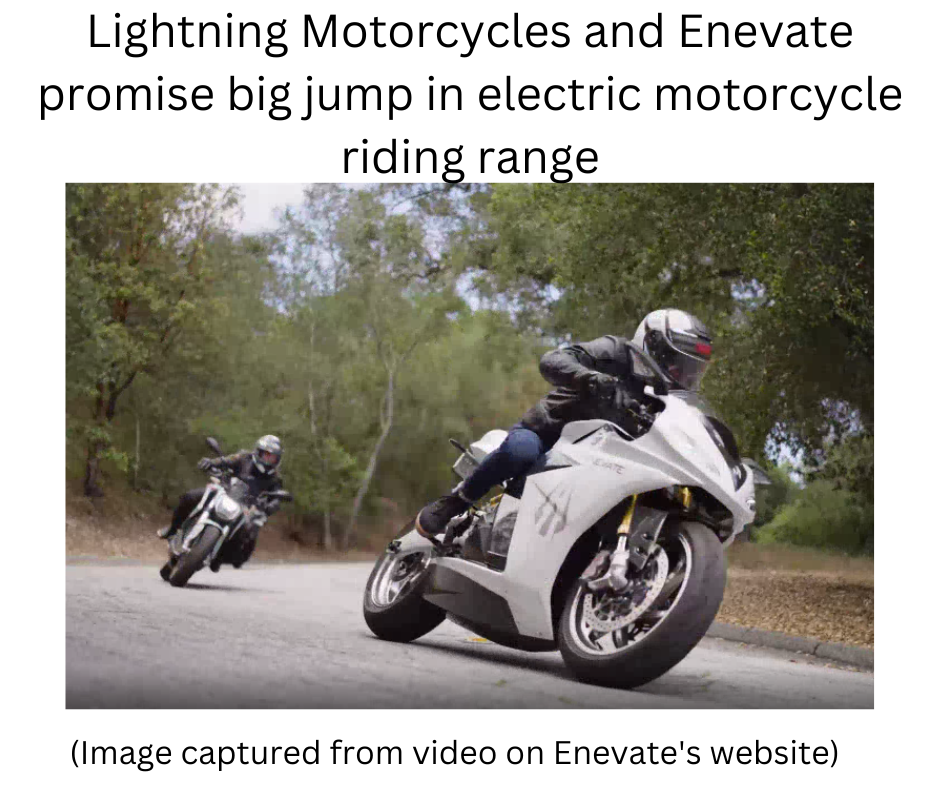The future of electric vehicles is starting to happen with a deal between Lightning Motorcycles and battery maker Enevate. Lightning has a long history of making fast and powerful electric motorcycles. Their partnership with Enevate makes Lightning one of the first companies to offer a Silicon-based EV battery. The new battery technology offers both a much quicker charge time and greater energy density which should boost overall riding range.
Lightning is targeting a start of production in “Early 2023” for a Lightning Strike Carbon motorcycle with the new battery technology.
Enevate has developed a new class of Li-Ion batteries that utilize silicon-dominant anodes. The company licenses technology out to vehicle manufacturers and battery manufacturers. The company makes these promises for its battery technology:
- 10X faster charging, and a 5-minute extreme fast charge
- 30% more EV range, due to higher energy density
- Enabling lower-cost batteries for lower-cost electric vehicles
- Greatly improved low-temperature performance
- Safer battery with no lithium plating
Electric motorcycles are extremely space constrained. A higher energy density means a manufacturer can squeeze in more kiloWatt-hours into the same space. That meant Lightning could put 24 kiloWatt-hours of battery into the Carbon Strike motorcycle.
The current Carbon Strike carries a maximum of 20 kiloWatt-hours, for which they claim 200 miles of range. DC Fast Charging is a $1500 option for the current model, offering 100 miles of range in a 35-minute charging time.
According to the joint press release from Lightning and Enevate![]() , Lightning integrated a 24 kiloWatt-hour battery pack into a Carbon Strike. In testing, they were able to charge the battery at 400 Amps, which is nearly a 5C charging rate. Computing the battery math, we estimate the battery pack is 80 Amp-Hours, and that the nominal pack voltage is in the 300-400 volt range.
, Lightning integrated a 24 kiloWatt-hour battery pack into a Carbon Strike. In testing, they were able to charge the battery at 400 Amps, which is nearly a 5C charging rate. Computing the battery math, we estimate the battery pack is 80 Amp-Hours, and that the nominal pack voltage is in the 300-400 volt range.
Lightning has tested the motorcycle for over 1000 miles using publicly available 350 kiloWatt charging stations. For a charging time of fewer than 10 minutes, the Carbon Strike motorcycle gained 135 miles of riding range.
Analysis
All the above sounds very interesting, but let’s ponder a few things.
First is that 1000 miles of testing are not enough. Between now and “early 2023”, we hope that Lightning is planning to do more testing. UPDATE: I reached out to Richard Hatfield, CEO of Lightning Motorcycles. He said that the 1000 miles of testing were what Enevate did before the press release. Lightning is continuing to test with these batteries, and Enevate, of course, did 1000s of test cycles prior to working with Lightning.
Most advanced battery announcements talk about small battery cells in artificial laboratory conditions. Because this is an instance where a full-scale battery pack has been built for a real vehicle, this is not that sort of announcement. Instead, it’s a real vehicle with a promised production date. This is a “wake up, this is getting real” moment.
However, neither Enevate nor Lightning have battery manufacturing capabilities. Enevate says its business is to license the technology to manufacturers, meaning they do not manufacture cells itself. They may have built prototype cells that Lightning used to build a prototype bike, but they will not be Lightning’s partner for full production.
Likewise, Lightning is not a battery manufacturer, but a motorcycle manufacturer. I believe that Lightning has the capability of manufacturing battery packs from battery cells. That means Lightning has an unnamed partner for cell manufacturing.
I notice that Enevate’s advisory boards![]() include representatives from Lenovo, LG Chem, Groupe Renault, Samsung, and Texas Instruments. Dr. Goodenough, the professor at UT Austin credited with many groundbreaking developments in lithium-ion batteries, is on the advisory board. This gives a lot of credibility to Enevate’s claims and points to possible manufacturing partners.
include representatives from Lenovo, LG Chem, Groupe Renault, Samsung, and Texas Instruments. Dr. Goodenough, the professor at UT Austin credited with many groundbreaking developments in lithium-ion batteries, is on the advisory board. This gives a lot of credibility to Enevate’s claims and points to possible manufacturing partners.
Racing?
Because Lightning Motorcycles has a history with electric motorcycle racing, let’s discuss what this could mean.
A long-time issue with electric motorcycle racing is the limited distance for the races. Typical gas bike races run for 60-80 miles total distance at speeds in the 150-200 miles/hr range. In the 2009-2013 time period, electric motorcycle races were running on the exact same tracks but limited to about 20 miles range in the 100-170 miles/hr range. For electric motorcycles to match the range/speed of gas bikes would be a serious game-changer.
In the 2009-2013 time frame I did a back-of-the-envelope calculation and determined that a 60-80 mile race would require over 30 kiloWatt-hours of battery capacity. Before you say the silicon-anode Carbon Strike should have 250 miles range, answer this: “What is the test cycle Lightning uses for estimating riding range?” Race conditions are a lot different, and use a lot more energy per mile, than street riding conditions.
Summary
Silicon-Lithium batteries have been on the horizon for a long time. Enevate doesn’t explicitly say this, but their batteries are not what’s called solid-state silicon batteries. Instead, the battery design uses silicon in the anode and a lithium-ion electrolyte. This isn’t too different from traditional lithium-ion battery cell designs.
On the Wikipedia page![]() , we see that volumetric distortion (a.k.a. swelling) is a big issue with silicon-lithium batteries. As the silicon matrix accepts lithium ions, it swells. But, Enevate has reached the point where they, and battery cell manufacturing partners, are going to production. They have an OEM vehicle manufacturer, Lightning Motorcycles, promising to start production very soon. This has to mean Enevate has solved the volumetric distortion problem.
, we see that volumetric distortion (a.k.a. swelling) is a big issue with silicon-lithium batteries. As the silicon matrix accepts lithium ions, it swells. But, Enevate has reached the point where they, and battery cell manufacturing partners, are going to production. They have an OEM vehicle manufacturer, Lightning Motorcycles, promising to start production very soon. This has to mean Enevate has solved the volumetric distortion problem.
While this is an exciting announcement for Lightning Motorcycles, it is more interesting to learn that the EV industry is on the cusp of switching to silicon batteries. If Enevate’s claims hold up (faster charging, lower cost) it will mean a big jump in electric vehicle capabilities are just around the corner.
In most years battery manufacturers make gradual incremental improvements. This is a completely different technology promising not an incremental improvement, but a large discontinuous improvement.
- The USA should delete Musk from power, Instead of deleting whole agencies as he demands - February 14, 2025
- Elon Musk, fiduciary duties, his six companies PLUS his political activities - February 10, 2025
- Is there enough Grid Capacity for Hydrogen Fuel Cell or Battery Electric cars? - April 23, 2023
- Is Tesla finagling to grab federal NEVI dollars for Supercharger network? - November 15, 2022
- Tesla announces the North American Charging Standard charging connector - November 11, 2022
- Lightning Motorcycles adopts Silicon battery, 5 minute charge time gives 135 miles range - November 9, 2022
- Tesla Autopilot under US Dept of Transportation scrutiny - June 13, 2022
- Spectacular CNG bus fire misrepresented as EV bus fire - April 21, 2022
- Moldova, Ukraine, Georgia, Russia, and the European Energy Crisis - December 21, 2021
- Li-Bridge leading the USA across lithium battery chasm - October 29, 2021























David,
Good of you to reach out to Hatfield. I understand that Lightning has long used Enerdel batteries, so perhaps that’s the manufacturer here: maybe worth a call? They are a small and high-end manufacturer, so this sort of new technology might be seen on their (local) small-batch manufacturing line.